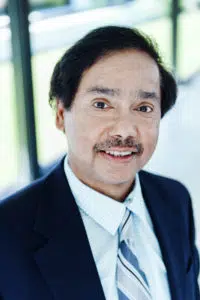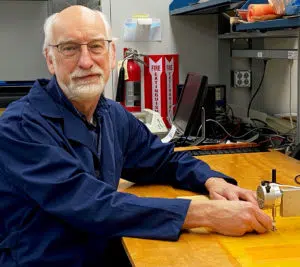Chief Technical Adviser to the CEO Zaki Ali and Senior Scientist Kevin Kidnie share what R&D means at Miraclon, why it matters, and how listening to – and even pre-empting – customers’ needs is key to staying ahead of the curve.
Cutting a new course isn’t something that happens overnight. Take transforming flexo. Twelve years ago, our scientists invented a technology platform that set new standards for flexo printing. Since then they have continued to define the direction of future innovation.
Unlike many technology companies, Miraclon’s R&D approach focuses on major developments rather than small, incremental gains. Why do you feel that’s a better way to work?
 ZAKI ALI: At Miraclon, we know true innovation lies in addressing fundamental challenges, not quick fixes. We’re not interested in making ‘me too’ products. We want to be providing the products that our customers need and our competitors can’t provide. Making lots of small improvements impacts efficiency, and often ends up causing problems which you then have to go back and fix. That’s just not an efficient way to work.
ZAKI ALI: At Miraclon, we know true innovation lies in addressing fundamental challenges, not quick fixes. We’re not interested in making ‘me too’ products. We want to be providing the products that our customers need and our competitors can’t provide. Making lots of small improvements impacts efficiency, and often ends up causing problems which you then have to go back and fix. That’s just not an efficient way to work.
KEVIN KIDNIE: What we’ve found is that once a product is on the market, making constant tweaks is inefficient – not only for us, but for our customers too. We prefer to bring out finished products that we know can do the job. We work really hard to involve the customer throughout the R&D process, but we also involve other teams like marketing, manufacturing and the tech application group to determine what areas we should be working on.
“We want to be providing the products that our customers need and our competitors can’t provide. Making lots of small improvements impacts efficiency, and ends up causing problems which you have to go back and fix. That’s just not an efficient way to work.”
There must be many technologies and products which show promise. How do you identify which areas to focus on?
ZAKI ALI: In R&D, it starts with making sure our research is aligned with the company’s goals, which all hinge around transforming flexo. Assets and resources are valuable, so we need to focus on the ideas that have the most promise – both for the company and our customers.
The next step is assessing the opportunities. There are all kinds of factors we use for that: market potential, development time, how it fits in with our other core technologies, the overall complexity of the project. Many parts of the company are involved in those decisions – not just R&D, but everyone from manufacturing to marketing.
 KEVIN KIDNIE: Sometimes it’s about solving a problem. Other times it’s simply because you see potential in something. I spend most of my time working in a lab at quite a small scale, and sometimes I see something that looks different or interesting, and start to wonder what could we do with that?
KEVIN KIDNIE: Sometimes it’s about solving a problem. Other times it’s simply because you see potential in something. I spend most of my time working in a lab at quite a small scale, and sometimes I see something that looks different or interesting, and start to wonder what could we do with that?
This is actually what led to the launch of the KODAK FLEXCEL NX System. We’d already been working with Thermal Imaging Layer (TIL) technology for some time when we realised we could use that technology to bring much greater accuracy to the flexo process. KODAK SQUARESPOT Imaging Technology enabled us to use TIL to translate high quality imaging onto the plate itself with 1:1 reproduction, which overcame one of the main limitations of conventional digital plate design. We already had this capability, but we found a new way to use it. Ultimately the KODAK FLEXCEL NX System came out of that. The result was a quantum leap in flexo print capability and the start of a step change in the industry.
How do you incorporate market/customer needs into the R&D process?
ZAKI ALI: Thinking about customers’ needs is an integral part of product development, but sometimes we’re working on technologies that customers aren’t even aware they need yet. As Kevin says, the FLEXCEL NX plate is a great example of that: customers didn’t even know they needed a “non-LAMS” product until they saw the FLEXCEL NX plates in action and realised their potential. It enabled us to optimize ink control for all applications. We could have developed a range of LAMS plates with different ink transfer characteristics for different applications, but we didn’t, because it would have added too much complexity for the customer. That’s a good example of how we’re always thinking about customers’ needs, and how our products will work out in a real world production environment.
Fundamentally, our approach is proactive, not reactive. We have a roadmap of products and new developments we’re working on, and we work closely with other teams to bring them to market at the best time and in the most effective way.
In your experience, what are the key ingredients in building a successful R&D team?
ZAKI ALI: That’s a difficult question to answer. For a small to medium-sized company like ours, participating in a semi-mature but growing market, it’s important to have a critical mass of our R&D employees located in one place, so they can work collaboratively on the product portfolio. You need the right mix of skills and expertise: we develop fully integrated solutions, so we need a full range of disciplines; chemists, polymer chemists, physicists, engineers, software architects. Everyone needs to be dedicated to their work and have a shared desire to move the company forward. But you also need a few creative thinkers who can challenge the status quo. Importantly, you also need a leader who can guide the team by example, not just by authority.
KEVIN KIDNIE: I agree with that. You need that mix of skills. For example, the manufacturing guys are engineers, so they think in really practical terms, but you really need the ideas people too. The R&D department is like a family. We work closely together, and the problems we’re working on are often way too big for us to handle on our own. A lot of people say you should ‘tell it like it is’, but in R&D, I like to think you need to ‘tell it like it isn’t’: in other words, that you can think of things beyond the now, and imagine how things could be.
That’s a key thing for the R&D group. Having that vision, imagination and exploration is what keeps us going. We have to work within the constraints that we have, but we like to push the boundaries as much as possible.
“A lot of people say you should ‘tell it like it is’, but in R&D, I like to think you need to ‘tell it like it isn’t’. In other words, that you can think of things beyond the now.”
Can you describe the process of getting a project from theory to reality?
Kevin Kidnie: Like many R&D departments, we use what’s called a Gate System for staging all out products. Ours runs from Gate Zero to Gate Six. At Gate Zero you just have an initial idea and maybe a few preliminary experiments; by Gate Six, you’ve basically got a robust, finished product ready for launch.
The great thing about the Gate system is that it allows you to evaluate your progress at multiple stages and keep checking on where you are compared to where you expected to be. It’s a rigorous process and can be adapted for projects that take as little as six months, or for more complex, fully integrated solutions that can take two or three years.
In your experience, what are the key ingredients in building a successful R&D team?
ZAKI ALI: That’s a difficult question to answer. For a small to medium-sized company like ours, participating in a semi-mature but growing market, it’s important to have a critical mass of our R&D employees located in one place, so they can work collaboratively on the product portfolio. You need the right mix of skills and expertise: we develop fully integrated solutions, so we need a full range of disciplines; chemists, polymer chemists, physicists, engineers, software architects. Everyone needs to be dedicated to their work and have a shared desire to move the company forward. But you also need a few creative thinkers who can challenge the status quo. Importantly, you also need a leader who can guide the team by example, not just by authority.
KEVIN KIDNIE: I agree with that. You need that mix of skills. For example, the manufacturing guys are engineers, so they think in really practical terms, but you really need the ideas people too. The R&D department is like a family. We work closely together, and the problems we’re working on are often way too big for us to handle on our own. A lot of people say you should ‘tell it like it is’, but in R&D, I like to think you need to ‘tell it like it isn’t’: in other words, that you can think of things beyond the now, and imagine how things could be.
That’s a key thing for the R&D group. Having that vision, imagination and exploration is what keeps us going. We have to work within the constraints that we have, but we like to push the boundaries as much as possible.
“A lot of people say you should ‘tell it like it is’, but in R&D, I like to think you need to ‘tell it like it isn’t’. In other words, that you can think of things beyond the now.”
What’s the best part for you about working in R&D?
KEVIN KIDNIE: For me, it’s seeing an idea that goes from lab scale to manufacturing scale and ultimately a product that’s out there on the market being used by customers – to grow their own businesses and make money. That’s definitely the most rewarding part.
ZAKI ALI: Yes. It’s developing unique products and solutions which solve fundamental challenges and enable our customers to work faster, more efficiently and with results that meet the ever increasing needs of their brand clients.
What are the technologies that we should be looking out for in the next few years?
KEVIN KIDNIE: Printing efficiency is going to be a big focus for us – products that are robust and with a wide operating latitude but don’t compromise on the quality bar we’ve set. Sustainability is another big area: It’s important to have sustainably-focused solutions while also improving efficiency and cost-effectiveness. There’s a lot that can be done to help printers reduce waste and improve their overall sustainability footprint. Products like the FLEXCEL NX Ultra solution for water-based platemaking are also where we’re looking to continue to innovate.
ZAKI ALI: We are on an innovation journey with our customers. All our innovations build on the prior one, so customers can be confident that we won’t send them off in a different direction. It’s a strategy that ultimately enables them to get the greatest return on their investments – and that’s important to us. We’ll continue innovating to help them meet, and hopefully exceed, their goals.